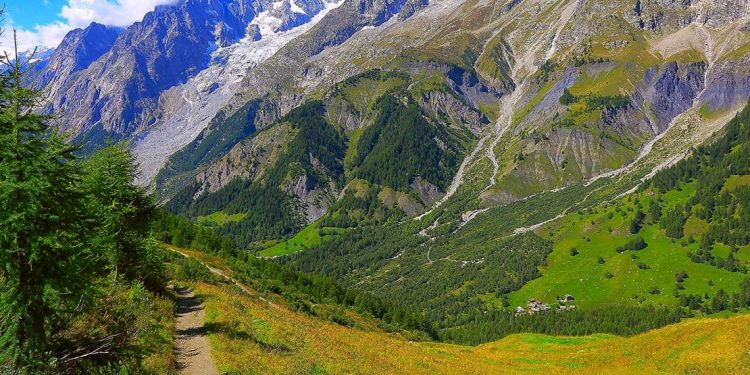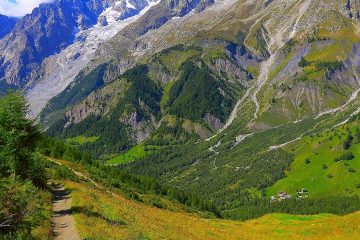
The Best Way to Experience Europe’s Natural Beauty
One of the best ways to explore Europe is on your own two feet. If you are wanting to avoid European tourist traps and get an authentic sense of what the continent has to offer, hiking from town to town is the way to do it.
Whether you are tackling mountains and fjords, or strolling through valleys awash with wildflowers, hiking Europe will give you a close-up view of the countries you are walking through.
You’ll catch the scent of freshly baked baguettes wafting from boulangeries in France, hear the jangle of cow bells in alpine meadows in Switzerland, and see life as it is in some of the highest and most isolated corners of Europe. Plus there many lessons hiking teaches you, so you’ll get a lot more out of the trip than just great photos.
Lace up your hiking boots and get your walking sticks out — you’re going to want to discover these incredible hikes in Europe.
Tour du Mont Blanc: Switzerland, France, Italy
Also known as the TMB, this is one of the most famous long distance hikes in the world. The track stretches around Mont Blanc for around 110 miles, passing through Switzerland, France and Italy.
The classic hike usually takes around 11 days, with hikers most commonly kicking off from Chamonix. Along the way you can choose from lots of accommodation options, tailoring the length of your days to suit your fitness.
This flexibility means people of all fitness levels can do the hike, but ideally you need some experience hiking in mountain terrain, and you should always go well-equipped with the right hiking gear as the weather can change rapidly.
Kungsleden: Sweden
Stretching for 270 miles, ‘The King’s Trail’ is truly a royal hike. Carving through Swedish Lapland’s incredible landscapes, you will get to enjoy dazzling scenery for the length of the hike.
The journey will take you through the Swedish mountains and across Vindelfjallen, one of the largest nature reserves in Europe.
The track is clearly marked and huts along the way are clean, simple, and manned by wardens who allocate beds. Hikers usually tackle the trek in summer.
You can undertake the hike in winter, travelling on skis, but the harsh weather can pose some risks. It’s recommended to join a tour group if you wish to take on this hike during this time.
With the Bali Twice the Magic package you'll be able to experience 2 Four Seasons resorts, getting a taste for different landscapes in Bali.
Bernese Overland Trails: Switzerland
A collection of trails, these hikes weave through Switzerland’s highlands (oberlands) and the foothills of the Swiss Alps. You’ll traverse quintessentially Swiss landscapes — think snowy peaks, rolling alpine fields and picturesque villages.
Hiking is a popular pastime in Switzerland and this enthusiasm means all the trails are well marked and easy to follow. You can do day hikes or match together several trails for a longer overnight experience.
The Camino de Santiago: Spain
The Camino de Santiago is actually a multitude of routes that crisscross Europe and ultimately end up in the same destination — Santiago de Compostela, Spain. Once upon a time, pilgrims walked the route in single file, aiming to get to the shrine of Saint James in Santiago, where legend has it the remains of the saint are buried.
The beauty of this hike is that you can join from anywhere you want. The hiking trails begin as far away as France and Italy, so you can customize your route depending on where you want to begin and how long you want to walk for.
Because of the number of people walking the Camino every year, there are plenty of accommodation options and a lot of information available, so it’s straightforward to undertake independently.
La Alta Via Uno: Italy
The Dolomites are a mountain range stretching through northeastern Italy. Characterized by craggy peaks with vertical cliffs, long, narrow valleys and a scattering of turquoise lakes, this is one of the most visually stunning places to hike in Europe.
Make sure you take your camera and some spare batteries — this is a landscape you will want to capture over and over again.
The Alta Via Uno is a 75 mile hike that reaches heights of just over 9,000 feet. Hikers usually allow 10 days to complete the trek, starting from the town of Dobbiacco and finishing in Belluno.
The Best Way to Experience Europe's Natural Beauty One of the best ways to explore Europe is on your own two feet. If you are wanting to avoid European tourist...
West Highland Way: Scotland
This 96 mile route crosses moors, cuts around lochs, and climbs the Devil’s Staircase. Running through the Scottish Highlands, this hike is simply spectacular, with unforgettable landscapes that have all the blustery wilderness Scotland is famous for.
About 80,000 people set foot on the path each year, and it’s not for nothing that the path is so popular. The hikes uses ancient roads that drovers, coachers, and the military used to take. Tradition dictates that the track is walked from south to north.
Vereda da Ponta de Sao Lourenco: Madeira, Portugal
Although this little island is far away from mainland Portugal, it still has some of Europe’s best walking routes. The volcanic island’s dry landscapes contrast beautifully with the blue ocean backdrop, and the island’s dramatic peaks ensure you get some fabulous views as you hike.
This particular walk takes in some of the best cliff scenery on the island, exploring a basalt peninsula covered with low trees. Along the way you can look out for goldfinches, canaries and even seals basking on the rocks below.
Deciding where to stay is often a pretty personal decision, based on your trip ideals. These hotels in London will suit every preference!
Slovenian Mountain Trail: Slovenia
Winding through the relatively undiscovered Julian Alps, this is a trek hiking enthusiasts shouldn’t miss. Along the length of the hike you will climb the country’s highest peak, Mount Triglav, delve into forests that hide ibex and eagles, and see Slovenia’s cultural heritage in remote mountain villages still untouched by the outside world.
The natural beauty of the area is outstanding, but as Slovenia is less known among hiking crowds, you won’t see as many people as you would in neighboring Italy or Switzerland. Because of the remote nature of the mountains, though, you will need to be well-prepared and self-sufficient in places.
